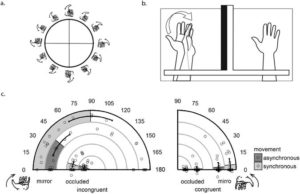 Our paper with Yuqi Liu (graduate student) is out in Scientific Reports. In it, we report a new version of the mirror box illusion. In it, participants place their hands in opposing postures (i.e. one hand palm down, the other hand palm up) in the mirror box and synchronously (or asynchronously) opened/closed their hands. In this condition, participants may see the reflection of their hand as palm up, while their actual hand (behind the mirror) is positioned palm down.
Our paper with Yuqi Liu (graduate student) is out in Scientific Reports. In it, we report a new version of the mirror box illusion. In it, participants place their hands in opposing postures (i.e. one hand palm down, the other hand palm up) in the mirror box and synchronously (or asynchronously) opened/closed their hands. In this condition, participants may see the reflection of their hand as palm up, while their actual hand (behind the mirror) is positioned palm down.
Interestingly, we found that for synchronous movements (when both hands opened/closed at the same time), participants reported feeling that the hand behind the mirror rotated, or “flipped” to match the position of their viewed hand. Importantly, the hand behind the mirror didn’t move – the perceived sensation was illusory.
 We then examined whether biomechanical constraints of the “body schema” (i.e. how can the arm realistically rotate) influenced the strength of the illusion. For example, place your hands as in Figure d. below. Rotating your left hand to match the position of the right hand is relatively easy. Now do the same movement using the starting position in Figure e. Note how the movement is more constrained at the end – this is due to biomechanical constraints that limit our movement. We found that participants showed a stronger illusion for less constrained movements vs. more constrained movements – a surprising result given that there was no actual movement involved in the task.
We then examined whether biomechanical constraints of the “body schema” (i.e. how can the arm realistically rotate) influenced the strength of the illusion. For example, place your hands as in Figure d. below. Rotating your left hand to match the position of the right hand is relatively easy. Now do the same movement using the starting position in Figure e. Note how the movement is more constrained at the end – this is due to biomechanical constraints that limit our movement. We found that participants showed a stronger illusion for less constrained movements vs. more constrained movements – a surprising result given that there was no actual movement involved in the task.
In this illusion, we propose that its effectiveness is dictated, not only by well-known principles of multisensory integration, but also by knowledge about the configuration of our bodies. This illusion is quite easy to do, and we suggest trying it at home – it’s quite compelling.
If you want to learn more about the mirror box illusion, see the video below and the related article in UDaily.
